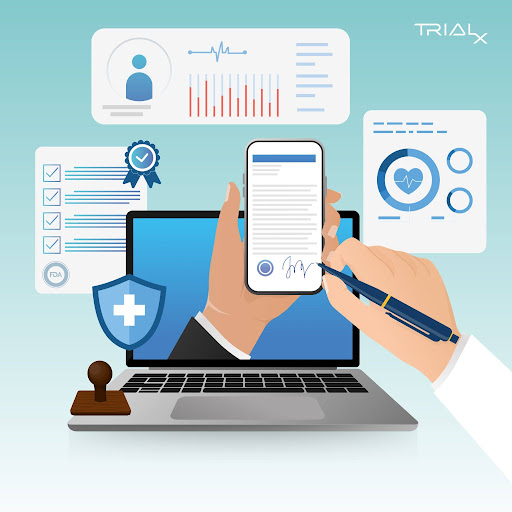FDA Guidance on Electronic Signatures in Clinical Trials – What Stakeholders Need to Know

Highlights
- Electronic signatures should be reliable and trustworthy and are legally equivalent to traditional handwritten signatures.
- Stakeholders shall ensure that all electronic signatures meet the regulatory requirements that include identity verification and proper audit trails.
- The FDA does not need to preapprove systems or methods of electronic signatures but requests organizations for a letter of non-repudiation to verify the legality.
The Food and Drug Administration (FDA) guidance on electronic systems, electronic records, and electronic signatures in clinical trials is a crucial update for sponsors, clinical investigators, institutional review boards (IRBs), contract research organizations (CROs), and other stakeholders involved in research on medical products, foods, tobacco products, and new animal drugs. With the increasing use of digital solutions in clinical research, especially in decentralized and hybrid trials, this guidance helps reinforce data integrity, access control, and the trustworthiness of electronic records. It provides valuable insights into handling electronic signatures to ensure that they are fully regulatory compliant and adhere to standards for both legal validity and traceability.
TrialX’s remote data collection platform exemplifies innovation in clinical trial technology, enabling diverse clinical trial participant engagement through mobile apps. Notably, astronauts on commercial space missions have used the platform to capture clinical data. As a leader in remote data collection and clinical trial patient recruitment, we align our solutions with the latest regulations to ensure that participant data remains secure, compliant, and reliable. Here we have distilled what stakeholders need to know in order to make sure participant data remains compliant and secure especially with regards to electronic signatures.
Understanding Electronic Signatures
An electronic signature, as defined by the FDA, is a computer-generated compilation of symbols or data authorized by an individual to serve as their legally binding equivalent to a handwritten signature. The FDA guidance sets out clear expectations for the use of electronic signatures. The agency mandates that electronic signatures should:
- Be unique to the individual.
- Be linked to their electronic records in a way that ensures they cannot be falsified.
- Include a full name and timestamp when applied to the electronic record.
- Be periodically tested to ensure ongoing security.
“In general, a signature may not be denied legal effect or validity solely because it is in an electronic format, and a record relating to a transaction may not be denied legal effect, validity, or enforceability solely because an electronic signature or electronic record was used in its formation. In general, electronic signatures and their associated electronic records that meet all applicable requirements under part 11 will be considered to be equivalent to handwritten signatures.” – FDA guidance document
Key Insights from FDA’s Q&A on Electronic Signatures
Q1. What methods might be used to create valid electronic signatures?
Part 11 does not describe a specific method of establishing valid electronic signatures, but they must be reliable and trustworthy. Methods include computer-readable ID cards, biometrics, digital signatures, and username-password combinations. Regulated entities must ensure that any commercial electronic signature services used meet part 11 requirements either through vendor documentation or independent validation, if necessary.
Q2. Does the FDA consider signatures drawn with a finger or an electronic stylus on a mobile platform or other electronic system to be electronic signatures?
No, signatures created using a finger or an electronic stylus are classified as handwritten signatures. A handwritten signature applied to an electronic record must be properly linked to that record. The signature should be displayed on the electronic document in the same manner it would appear on a printed document, ensuring it is clearly associated with the corresponding electronic record.
Q3. How should regulated entities verify the identity of the individual who will be electronically signing records as required in § 11.100(b)?
Part 11 rules don’t require a specific way to verify someone’s identity for electronic signatures. Common methods include using official government-issued ID, answering security questions, or using strong digital login credentials with extra security like multi-factor authentication or video verification.
Q4. What requirements must an electronic signature based on biometrics meet to be considered acceptable?
Biometrics are a way to verify a person’s identity by measuring unique physical traits or actions, such as fingerprints, hand size, iris patterns, retinal patterns, or voice prints. Biometric-based electronic signatures must be designed so that only the rightful owner can use them. The chosen biometric must be unique to the person and remain consistent over time. When biometric electronic signatures meet part 11, subpart C requirements, they are considered secure, reliable, and equivalent to handwritten signatures.
Q5. Does the FDA certify electronic systems and methods used to obtain electronic signatures?
No, the FDA does not certify electronic systems or methods for electronic signatures. Electronic signatures are considered trustworthy and equivalent to handwritten signatures as long as they, and their associated records, meet Part 11 requirements, no matter the technology or brand used.
Q6. Are users of electronic signatures required to submit letters of non-repudiation to the FDA to certify that an electronic signature is the legally binding equivalent of a traditional handwritten signature?
Yes, users of electronic signatures must send a letter of non-repudiation to the FDA before or when using an electronic signature. This letter certifies that the electronic signature is legally equivalent to a handwritten signature. One letter can cover all electronic signatures used by an organization. Instructions for submitting a non-repudiation letter, either online or by mail, are available on the FDA’s website.
Electronic signatures are essential in modern clinical trials, enabling secure, efficient, and compliant data management. Adhering to FDA guidelines ensures regulatory compliance, data integrity, and legal validity. With the shift to decentralized and hybrid trials, adopting compliant digital solutions is critical. TrialX’s remote data collection platform addresses these needs by seamlessly integrating secure electronic signatures, audit trails, and robust data management, supporting sponsors in maintaining compliance and optimizing efficiency.
For more detailed information on electronic systems, electronic signatures, and electronic records in clinical trials, you can access the full FDA guidance document here.
#digitalhealthtechnology #clinicaltrialstechnology #decentralizedclinicaltrials #remotedatacollection #clinicaltrials

